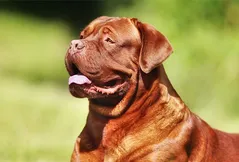
Basset Fauve de Bretagne
The Basset Fauve de Bretagne is a lovable small dog with short legs and a compact frame. He is smart, courageous and determined.
Overall Status
| Height | 12.5 to 15.5 inches |
| Temperament | Smart, Cheerful, Determined |
| Weight | 27 to 35 pounds |
| Life Expectancy | 12+ years |
| Coat Color | Fawn |
| Barking Level | Medium |
Quick Factors
| Playfulness | |
| Dog Friendly | |
| Exercise Need | |
| Grooming Needs | |
| Strangers Friendly | |
| Family Affectionate |
Daily Care
Grooming Tips
The Basset Fauve de Bretagne is almost a “wash-and-wear” dog, with a coarse, wiry coat that repels dirt and resists matting.Longhaired dogs can be hand-stripped. All require grooming weekly with a fine-toothed comb, followed by a stiff brush. Shedding is seasonal. Nails should be trimmed regularly to avoid overgrowth and splitting. Teeth should be brushed and ears checked regularly.
Exercise Tips
Basset Fauves are energetic and love to play. Regular walks need to be on a leash as they can run off and follow their nose at a moment’s notice. Areas for exercise and play, such as a backyard, should be fenced for the same reasons.Exercise can also come in the form of indoor activities, like hide-and-seek, chasing a ball rolled along the floor, or teaching them new tricks.Training for dog sports like agility, obedience and rally can also be a great way to give your dog exercise.
Feeding Tips
The Basset Fauve de Bretagne is a small-breed dog so it should be fed a dog food diet formulated for dogs of its size.Small-breed dogs have high energy needs and fast metabolisms so their diet should container higher levels of fat (a highly concentrated source of energy) than a diet for large-breed dogs.Make sure to choose a diet made from high-quality ingredients including animal proteins.
Health Tips
The Basset Fauve de Bretagne is a fairly healthy and hardy breed that lives up to 14 years on average. Though generally healthy, all dogs are prone to developing certain health problems. The problems most likely to affect the Basset Fauve de Bretagne breed include ear infections, cataracts, kidney failure, corneal ulcers, and reproductive problems.
Trainability
The Basset Fauve de Bretagne is a smart and trainable breed that excels particularly well in hunting. Because this breed was developed to hunt independently it can be a little willful and independent at times, but consistent and firm training will make him a great family pet.The Basset Fauve de Bretagne works well with other dogs and generally doesn’t have a problem with destructive behaviors as long as he receives enough exercise. This breed does, however, require plenty of attention and mental stimulation to prevent him from developing problem behaviors.
History
The Basset Fauve de Bretagne is truly an old French hound, tracing back to the 1500s when Francois I had a pack of Breton hounds he hunted regularly.The Grand Fauve de Bretagne (Fawn Hound of Brittany) was larger (27.5-29.5 inches) and was introduced to the French court around 1520 by Admiral d’Anneboulde.In the pack owned by Francois I, there was a stud dog named Mirraud, who was used extensively by royalty.In 1789, aristocratic privileges were abolished, allowing anyone to own and hunt a hound. Most peasants, however, did not own a horse, necessitating a shorter-legged, closer-ranging hunting companion. Thus, Bassetwas developed.By the 19th century, hound packs were made up exclusively of Bassets to hunt rabbits, hare, fox, roe deer and wild boar.Now, the breed still remains a popular, versatile hunting hound and family dog in France is gaining popularity in the United States and has breed clubs in numerous countries.






